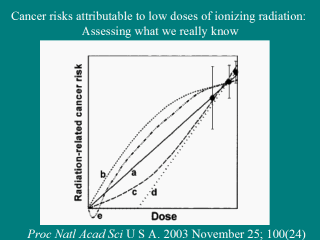 |
Upwardly Curving Dose–Effect Relations
(Fig. 3, Curve c). Upwardly curving (increasing slope) dose–effect relations
provide a good description of acute dose–effect relations for
radiation-induced leukemia in humans, and also of acute dose–effect
relations for chromosome aberration induction. Such dose–response data have
been extensively analyzed by using mechanistically motivated models such as
linear-quadratic and related approaches, or by modeling competition between
different re-combinational processes These upwardly curving dose–effect
models generally reduce to simple linear models at sufficiently low doses or
dose rates.
“High doses of ionizing radiation clearly produce deleterious consequences
in humans, including, but not exclusively, cancer induction. At very low
radiation doses the situation is much less clear, but the risks of low-dose
radiation are of societal importance in relation to issues as varied as
screening tests for cancer, the future of nuclear power, occupational
radiation exposure, frequent-flyer risks, manned space exploration, and
radiological terrorism. We review the difficulties involved in quantifying
the risks of low-dose radiation and address two specific questions. First,
what is the lowest dose of x- or ?-radiation for which good evidence exists
of increased cancer risks in humans? The epidemiological data suggest that
it is ?10–50 mSv for an acute exposure and ?50–100 mSv for a protracted
exposure. Second, what is the most appropriate way to extrapolate such
cancer risk estimates to still lower doses? Given that it is supported by
experimentally grounded, quantifiable, biophysical arguments, a linear
extrapolation of cancer risks from intermediate to very low doses currently
appears to be the most appropriate methodology. This linearity assumption is
not necessarily the most conservative approach, and it is likely that it
will result in an underestimate of some radiation-induced cancer risks and
an overestimate of others.” Proc Natl Acad Sci U S A. 2003 November 25;
100(24)
|
